Dacia Jogger
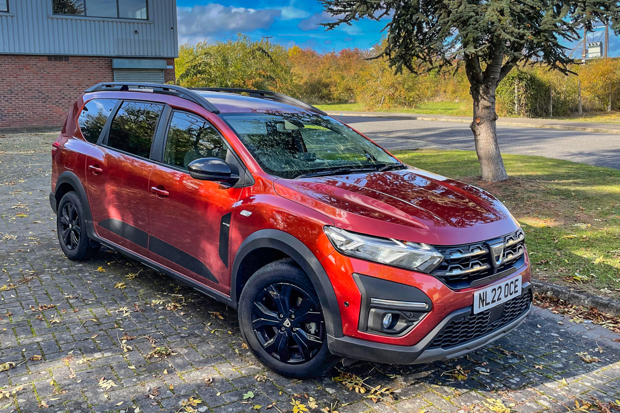
Specifications: Dacia Jogger TCe 110 Extreme SE
- Run by: Sarah Tooze since October 2022
- Price when new: £18,745 (£19,640 including options)
- Engine: 1.0-litre 3cyl turbocharged petrol
- Power: 109PS
- Torque: 200Nm
- Claimed economy: 48.7mpg
- CO2 emissions: 130g/km
- Insurance group: 16
Report 1: Meet our new Dacia Jogger Extreme SE
The Dacia Jogger has seven seats but costs less than most small cars. Is it actually any good?
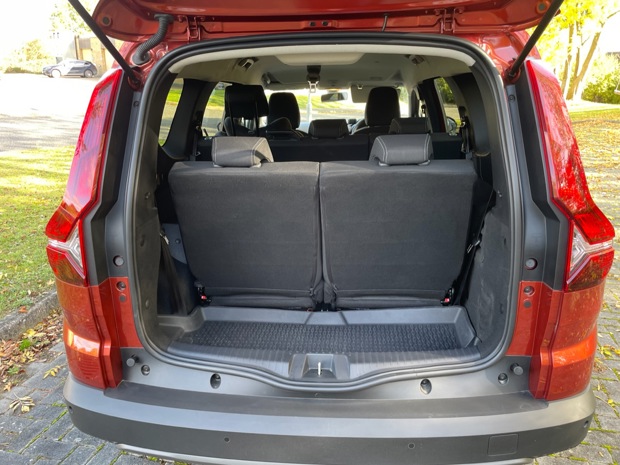
Date: 20 November 2022 | Current mileage: 6743 | Claimed economy: 48.7mpg | Actual economy: 43.3mpg
Driving the Dacia Jogger has been my introduction to Renault’s budget brand, and it’s certainly not a bad place to start.
The Jogger is Dacia’s latest model and also its most ‘expensive’, with the manufacturer recommended retail price starting at just over £17,000 (up from £14,995 at launch last year - blame inflation and the chip shortage). You get a lot of car for your money as the Jogger is essentially a stretched estate version of the popular Sandero, with seven seats as standard.
If you don’t have a tribe of kids you shouldn’t dismiss the Jogger as the third row of seats can be removed, which increases boot space significantly. With the seats in place the boot can accommodate little more than a few bags of shopping so I quickly realised that for a family of three it was more practical to take them out or use another car when a full boot load is needed. I will, however, be putting those two extra seats to the test - as soon as I can ‘borrow’ some of my friends’ children.
On the road the Jogger’s 1.0-litre petrol engine isn't the most refined unit of its type - something a colleague told me to expect, although he was quick to add that he likes the Jogger. And there is a lot to like about it. As a brand, Dacia topped last year’s Honest John Satisfaction Index, based on the views of more than 5,000 car owners.
Euro NCAP controversially awarded the Jogger a one star safety rating (they actually just tested a Sandero, which still achieved four stars for outright crash protection) marking it down for a lack of features such as lane assist. Our top spec model (Extreme SE) does come with autonomous emergency braking (AEB), but it doesn't detect cyclists or pedestrians, while blind spot warning, front and rear parking sensors and a reversing camera are also standard.
There are other creature comforts such as a keyless entry card, heated door mirrors, heated front seats and an eight-inch infotainment system with a built-in sat-nav, as well as the option of specifying a spare wheel (hurrah) for £300.
Our test car has terracotta bronze metallic paint, which is an optional extra for £595, but all this still brings the Jogger under the £20,000 mark (£19,640 to be precise), which is great value for money.
Be aware, if you do opt for entry level Essential model you get a phone holder instead of an infotainment screen, with the idea being that you can plug your phone in to use the car’s speakers and use Google maps or similar for navigation. But then it's the cheapest seven-seater you can buy new, so there's got to be compromises somewhere.
Report 2: We take a look at the Dacia Jogger's interior...
Our tester prefers the Jogger's built-in navigation to Android Auto or Apple CarPlay.
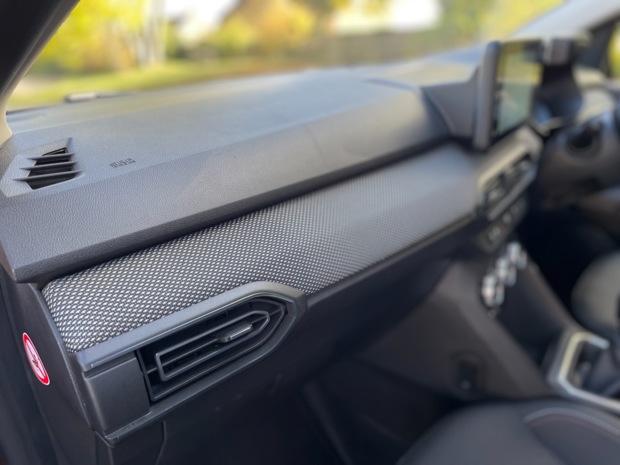
Date: 14 November 2022 | Current mileage: 6952 | Claimed economy: 48.7mpg | Actual economy: 43.3mpg
I have a confession to make. I secretly prefer using a built-in sat-nav rather than using Apple CarPlay or Android Auto. I know, I know, I sound like a luddite. But I find it easier than having to faff about plugging in my phone, relying on having a 3G/4G signal or risking burning through my data allowance.
So I was pretty pleased that the Dacia Jogger we’re testing is the top spec Extreme SE, which has a sat-nav as standard and not the entry-level Essential or mid-spec Comfort. The latter comes with an eight-inch display system and is compatible with Apple CarPlay and Android Auto while the Essential trim relies on a smartphone entirely (although, as I said in my first review, there’s got to be compromises somewhere with a seven-seater this cheap).
Surprisingly, you don’t need to plug your smartphone in via the USB port to use Apple CarPlay or Android Auto on the Extreme SE version as it comes with wireless smartphone mirroring, which is the kind of feature lacking on quite a few much more expensive cars.
I was also surprised to discover that the interior of the Jogger is not awash with cheap plastic. OK, there’s some but there’s an interesting textile strip across the dashboard and on the front door armrests, which breaks it up. It's definitely a step forward from older Dacias.
The front and rear door pockets are generous and can hold a one-litre bottle and there are extra features such as fold-down tray tables and cup holders for the second-row seats.
Keyless entry (Comfort and Extreme SE levels) is a nice-to-have feature but I’ve found it annoyingly eager to lock the car whenever I walk from the rear passenger side to the driver’s side.
On the flip side, when my arms are full with shopping bags and a toddler it's very handy to have the car unlock for you without having to press a button.
Our top spec model also has the benefit of heated seats, which I know I'll appreciate over the winter months. Really, you don't feel like you're missing out on anything important with the Jogger - great given the savings on offer compared with other seven-seaters.
Report 3: How practical is the Dacia Jogger?
We've put the Dacia Jogger to test as Christmas tree transport.
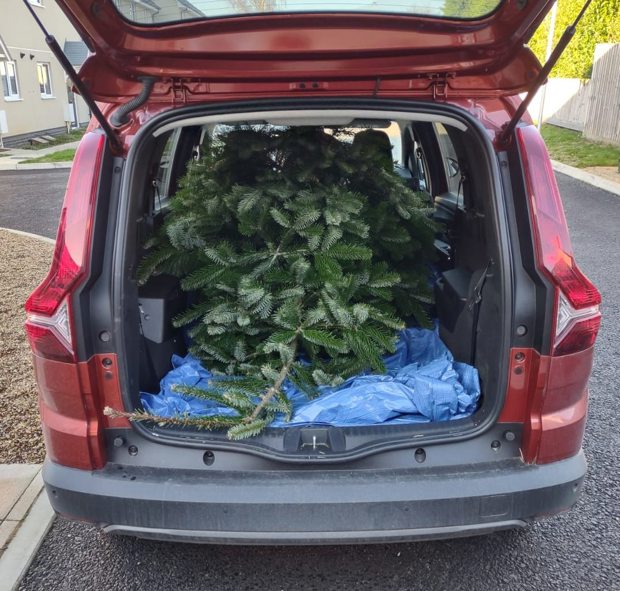
Date: 28 November 2022 | Current mileage: 7122 | Claimed economy: 48.7mpg | Actual economy: 43.1mpg
Dacia boasts that the Jogger has almost 60 possible configurations and up to 2,085 litres of cargo space. The latter is with the third row of seats removed and the second row of seats tumbled forward.
In that configuration the Dacia Jogger can truly rival - and even exceed - the space offered by an estate car. The Mercedes-Benz E-Class Estate, for example, has 1,820 litres of cargo space with the seats folded flat.
So when my husband was given a seven foot Christmas tree by his employer we knew instantly that transporting it home was a job for the Jogger.
As you can see in the picture above we did have to cheat a little bit by bending the top of the tree, but the Jogger had no trouble accommodating the tree’s width.
Removing the two seats from the third row is relatively straightforward using the red levers and pull loops, and the seats themselves weigh about 10 kilograms each so aren’t too heavy to carry. Luckily we have a garage so can store them away easily when we don’t need them.
If you don’t have space to store them the other option to create more boot space is to fold the seats (although they don’t fold completely flat due to the spare wheel beneath the floor) or tumble those forward which increase the boot space from 212 litres to 699 litres.
The Dacia Jogger’s other main practical feature is the modular roof bars (standard on Comfort and Extreme SE), which can carry up to 80kg. You can change the position of them manually with a key and they’re ideal for carrying a roof box, bike rack or even something like a snowboard or kayak.
Next time we’ll look at how much space the third row offers for passengers. Dacia says it will fit adults, not just children, so we’ll be putting that to the test.
Report 4: Is the Dacia Jogger a true seven-seater?
Is the Dacia Jogger a ‘true’ seven-seater car? We test whether two tall adults can comfortably sit in the third row of seats

Date: 19 February 2023 | Current mileage: 7520 | Claimed economy: 48.7mpg | Actual economy: 43.2mpg
We often get readers wanting to know via Ask HJ which seven-seater cars can carry seven adults and which seven-seaters are best for families. Dacia promises that the Jogger works for both scenarios.
To put that promise to the ultimate test I asked my five-foot-nine-inches tall friend Liz and her six-foot-eight-inches tall husband Piers to try out the third row of seats in the Jogger, while their daughter and mine tried out the second row.
It’s worth noting that there are no Isofix points in the back row or the front passenger seat of the Jogger, just two in the second row, so the girls’ car seats needed to go there, which won’t suit all families.
Of course, fitting both child car seats makes it impossible to access the back row as at least one seat needs to be flipped forward. This means waiting for passengers to get into the back then fitting the car seat and removing it before they can get out again, which isn’t great if you’re in a hurry. The fact the back row isn’t easily accessible also left my friends feeling a bit nervous about how they would get out of the car in the event of an accident.
What about the all-important leg and headroom? As you can see from the photo, Piers found his head was touching the roof - not a great surprise given his height - and although Liz had more space, both of them found their knees were pressed against the second row of seats. Liz described it as “claustrophobic” and didn’t want to travel a long distance. However, Piers was more forgiving of the Jogger, particularly when I told him the budget price tag of £17,145, with our top spec model costing £19,640 (including options).
As I’m only five-foot-two-inches tall I decided to see for myself what it is was like to sit in the back row. I found the room was good enough, although I didn’t test it on a long journey. So, yes, the Jogger can fit two tall adults in the back row but not comfortably - for that you need to be on the short side, like me.
Our advice remains that if you want a car that will carry seven adults in comfort then you'll need a van-based people carrier like the Ford Tourneo Custom, Volkswagen Multivan or Vauxhall Vivaro Life. But for occasional trips with seven adults then the Jogger is up to the job, especially as it’s half the price of those models.
The Jogger also ticks the box as a seven-seater car for families (provided you don’t need to fit three Isofix car seats).
Report 5: Farewell to the Dacia Jogger
Our three-month test of the Dacia Jogger has come to an end, so what was our final verdict?
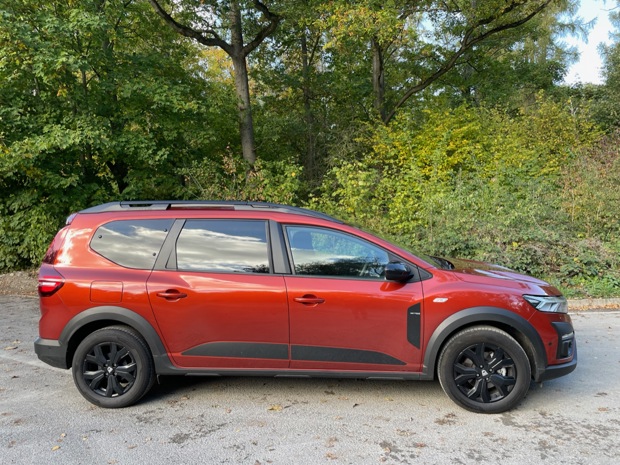
Date: 10 January 2023 | Current mileage: 7919 | Claimed economy: 48.7mpg | Actual economy: 43.1mpg
We said farewell to the Dacia Jogger on the same day that UK orders opened for the Jogger Hybrid 140, with deliveries expected in the second quarter of 2023.
It’s Dacia’s first hybrid car, combining a 1.6-litre petrol engine with two electric motors and a 1.2kWh battery, and is priced from £22,595, which is £4140 more than the equivalent petrol. However, the official average combined fuel economy figure for the hybrid is 56.5mpg, compared with 48.7mpg for the petrol.
Dacia suggests the Jogger Hybrid can spend up to 80 per cent of its time in full-electric mode on urban roads, saving drivers up to 40 per cent on fuel compared to an equivalent petrol-only model.
That’s tempting when you consider that during our three-month test of the 1.0-litre petrol we averaged around the 43.0mpg mark - about 5.0mpg below the official combined figure, with most of my journeys being short trips in rural and urban areas.
The Jogger’s infotainment system (not available on the entry level Essential model) does have an eco coaching feature, along with an eco score for acceleration, gear shift and anticipation, which made it clear that I needed gentle acceleration and to change gear sooner to boost my mpg.
On the road the Jogger’s lack of refinement was noticeable but that’s to be expected given its budget price tag, and it didn’t trouble me enough that I disliked driving it.
I found the Jogger’s biggest strength was its versatility - on the occasions when I needed a big boot being able to take out the third row of seats and tip the second row forward freed up a huge 2,085 litres of cargo space. And if I’d needed to I could have turned its clever roof rails into a full-on roof rack, able to carry up to 80kg. It is also possible for adults to travel in the third row - although if you’re tall it won’t be comfortable, as my friends discovered.
Overall, if you’re looking for a wallet-friendly family estate/SUV, only occasionally need seven-seats and aren’t bothered about having the latest safety technology then the Jogger could be just what you’re after.
